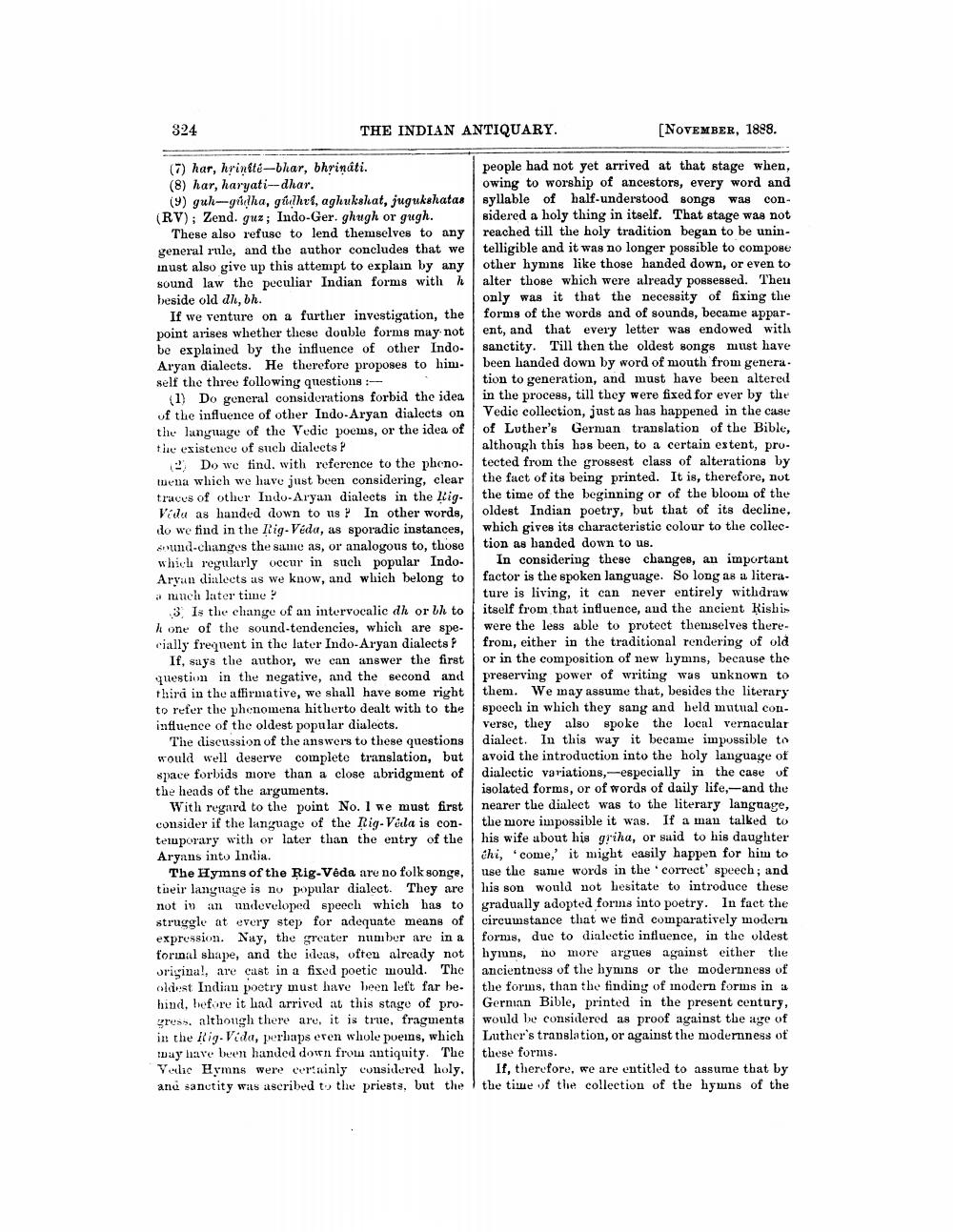________________
324
THE INDIAN ANTIQUARY.
[NOVEMBER, 1888.
(7) har, hrinité-bhar, bhrinkti.
people had not yet arrived at that stage when, (8) har, haryati--dhar.
owing to worship of ancestors, every word and (9) gul-gidha, gadhri, aghukshat, jugukshatas syllable of half-understood songs was con(RV): Zend. guz; Indo-Ger. ghugh or gugh. sidered a holy thing in itself. That stage was not
These also refuse to lend themselves to any reached till the holy tradition began to be uningeneral rule, and the author concludes that we telligible and it was no longer possible to compose inust also give up this attempt to explain by any other hymne like those handed down, or even to sound law the peculiar Indian forms with h alter those which were already possessed. Then beside old an,bh.
only was it that the necessity of fixing the If we venture on a further investigation, the forms of the words and of sounds, became appar. point arises whether these double forms may not ent, and that every letter was endowed with be explained by the influence of other Indo. sanctity. Till then the oldest songs must have Aryan dialects. He therefore proposes to him. been handed down by word of mouth from genera. self the three following questions :
tion to generation, and must have been altered (1) Do general considerations forbid the idea in the process, till they were fixed for ever by the of the influence of other Indo-Aryan dialects on Vedie collection, just as has happened in the case the language of the Vedic poems, or the idea of of Luther's German translation of the Bible, tine existence of such dialects
although this hos been, to a certain extent, pro. Do we find, with reference to the pheno. tected from the grossest class of alterations by tena which we have just been considering, clear the fact of its being printed. It is, therefore, not traces of other Indo-Aryan dialects in the Kig. the time of the beginning or of the bloom of the Vida as handed down to us? In other words, oldest Indian poetry, but that of its decline, do we find in the Rig Veda, as sporadic instances, which gives its characteristic colour to the collecstund-changes the same as, or analogous to, those
tion as handed down to us. which regularly occur in such popular Indo- In considering these changes, an important Aryun dinlects us we know, and which belong to factor is the spoken language. So long as a literamuch later time?
ture is living, it can never entirely withdraw 3 Is the change of an intervocalic dh orth to itself from that influence, and the ancient Rishis h one of the sound-tendencies, which are spe- were the less able to protect themselves therecially frequent in the later Indo-Aryan dialects P from, either in the traditional rendering of old
If, says the author, we can answer the first or in the composition of new hymns, because the question in the negative, and the second and preserving power of writing was unknown to third in the affirmative, we shall have some right them. We may assume that, besides the literary to refer the phenomena hitherto dealt with to the speech in which they sang and held mutual coninfluence of the oldest popular dialects.
verse, they also spoke the local vernacular The discussion of the answers to these questions dialect. In this way it became impossible to would well deserve complete translation, but avoid the introduction into the holy language of space forbids more than a close abridgment of dialectic variations, especially in the case of the heads of the arguments.
isolated forms, or of words of daily life, and the With regard to the point No. 1 we must first nearer the dialect was to the literary language, consider if the language of the Rig Veda is con- the more impossible it was. If a man talked to temporary with or later than the entry of the his wife about his griha, or said to his daughter Aryans into India.
thi, come, it might easily happen for him to The Hymns of the Rig Veda are no folk songe, use the same words in the correct speech; and their language is no popular dialect. They are his son would not hesitate to introduce these not in an undeveloped speech which has to gradually adopted forms into poetry. In fact the struggle at every step for adequate means of circumstance that we find comparatively modern expression. Nay, the greater number are in a forms, due to dialectic influence, in the oldest forinal shape, and the ideas, ofreu already not hymns, no more argues against either the original, are cast in a fixed poetic mould. The ancientness of the hymns or the modernness of oldest Indian poetry must have been left far be. the forms, than the finding of inodern forms in a hind, before it had arrived at this stage of pro- German Bible, printed in the present century, gress, although there are, it is true, fragments would be considered as proof against the age of in the Rig. Vida, perhaps eren whole poeins, which Luther's translation, or against the moderness of may have been handed down from antiquity. The these forms. Velie Hymns were certainly considered holy, If, therefore, we are entitled to assume that by ani sanctity was ascribed to the priests, but the the time of the collection of the hymns of the




